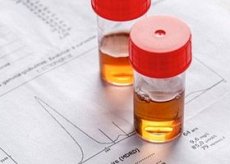Medical expert of the article
New publications
Diagnosis of pyelonephritis
Last reviewed: 03.07.2025

All iLive content is medically reviewed or fact checked to ensure as much factual accuracy as possible.
We have strict sourcing guidelines and only link to reputable media sites, academic research institutions and, whenever possible, medically peer reviewed studies. Note that the numbers in parentheses ([1], [2], etc.) are clickable links to these studies.
If you feel that any of our content is inaccurate, out-of-date, or otherwise questionable, please select it and press Ctrl + Enter.

Diagnosis of pyelonephritis is based on characteristic clinical manifestations and the results of laboratory and instrumental studies:
- determination of characteristic local symptoms (pain and muscle tension in the lumbar region, positive tapping symptom);
- studies of urine sediment using quantitative methods;
- bacteriological examination of urine;
- functional studies of the kidneys (decreased urine density, possible azotemia);
- ultrasound examination of the kidneys;
- excretory urography;
- dynamic scintigraphy;
- CT and MRI.
Examination and physical examination for pyelonephritis
During examination, signs of dehydration and a dry, coated tongue are usually noticeable. Abdominal distension, forced flexion and adduction of the leg to the body on the affected side are possible. Muscle tension in the lumbar region, pain during simultaneous bilateral palpation of the kidney area, and sharp pain in the costovertebral angle of the corresponding side are noted. A rapid pulse is determined; hypotension is possible.
Laboratory diagnostics of pyelonephritis
Characteristic laboratory signs of pyelonephritis include:
- bacteriuria;
- leukocyturia (may be absent in case of ureteral occlusion on the affected side);
- microhematuria;
- proteinuria (usually does not exceed 1-2 g/day);
- cylindruria.
Macrohematuria is possible with renal colic caused by urolithiasis, as well as with papillary necrosis. The relative density of urine may decrease not only in the chronic course of the disease, but also transiently in the acute stage of the disease. Leukocytosis with a shift in the leukocyte formula to the left (a particularly significant shift in the leukocyte formula is observed in purulent infection), a moderate decrease in the hemoglobin level, and an increase in ESR are determined. In the acute stage of the disease, with the involvement of the second kidney in the process, an increased content of urea and creatinine in the blood serum may be observed.
As a rule, diagnosing acute forms of pyelonephritis does not cause much difficulty - it is much more difficult to diagnose chronic forms, especially with a latent (hidden) course.
Instrumental diagnostics of pyelonephritis
In acute pyelonephritis, ultrasound examination allows us to determine:
- relative increase in kidney size;
- limited mobility of the kidneys during breathing due to swelling of the paranephric tissue;
- thickening of the renal parenchyma due to interstitial edema, the appearance of focal changes in the parenchyma (hypoechoic areas) in purulent pyelonephritis (in particular, in renal carbuncle);
- expansion of the renal pelvis and calyces due to obstruction of urine outflow.
In addition, ultrasound examination allows to detect stones and anomalies of kidney development. Later manifestations (in chronic pyelonephritis) include:
- deformation of the kidney contour;
- reduction of its linear dimensions and thickness of the parenchyma (change in the renal-cortical index);
- coarsening of the contour of the cups.
Using X-ray examination methods, it is possible to identify:
- dilation and deformation of the renal pelvis;
- spasm or expansion of the necks of the cups, changes in their structure;
- pyelectasis;
- asymmetry and unevenness of the contours of one or both kidneys.
Radionuclide methods allow the identification of functioning parenchyma, delimiting areas of scarring.
Computed tomography does not have any major advantages over ultrasound and is used mainly for:
- differentiation of pyelonephritis from tumor processes;
- clarification of the characteristics of the renal parenchyma (in acute pyelonephritis, it allows for detailed destructive changes in the renal parenchyma), renal pelvis, vascular pedicle, lymph nodes, and paranephric tissue.
The advantage of MRI is the possibility of its use in cases of intolerance to contrast agents containing iodine, as well as in chronic renal failure, when the administration of contrast agents is contraindicated.
Renal biopsy is not of great importance for diagnosis due to the focal nature of the lesion.
Diagnosis of chronic pyelonephritis should include anamnestic indications of previous episodes of acute pyelonephritis (including gestational in women), cystitis, and other urinary tract infections.
Differential diagnosis of pyelonephritis
In acute pyelonephritis, it is necessary to exclude cholecystitis, pancreatitis, appendicitis, in women - adnexitis (and other gynecological pathology), in men - prostate diseases. In children, elderly and senile patients, it is necessary to keep in mind the need for differential diagnostics of acute pyelonephritis with acute infections (flu, pneumonia, some intestinal infections). Great difficulties arise in differential diagnostics of apostematous nephritis. In these cases, computed tomography is the most diagnostically reliable.
Diagnostic criteria for acute pyelonephritis:
- pain in the lumbar region, fever, chills, excessive sweating, dysuria;
- positive Pasternatsky's symptom;
- positive results of the rapid test for bacteriuria and leukocyturia.
In women, gynecological pathology must be excluded; in men, prostate disease.
Chronic latent pyelonephritis is similar in clinical presentation to chronic latent glomerulonephritis, chronic interstitial nephritis, hypertension, and renal tuberculosis, therefore differential diagnosis of pyelonephritis is based on identifying the asymmetric nature of kidney damage (scintigraphy, excretory urography, ultrasound), characteristic changes in urine sediment, and anamnesis data.


 [
[